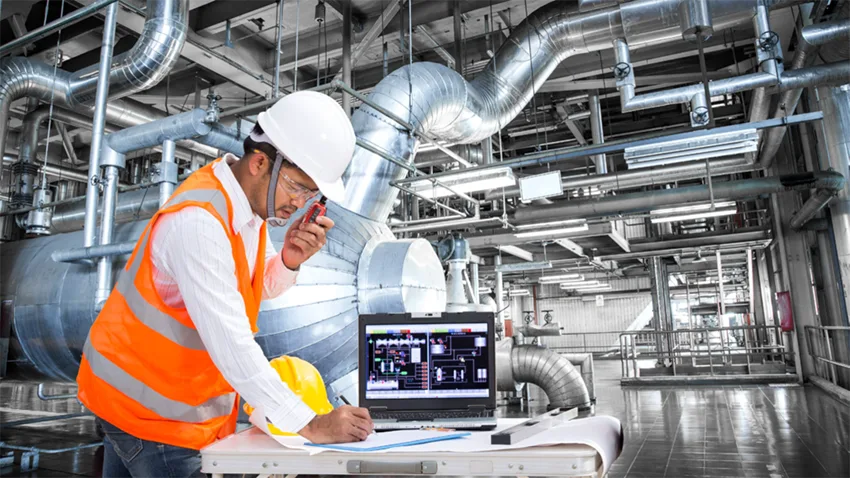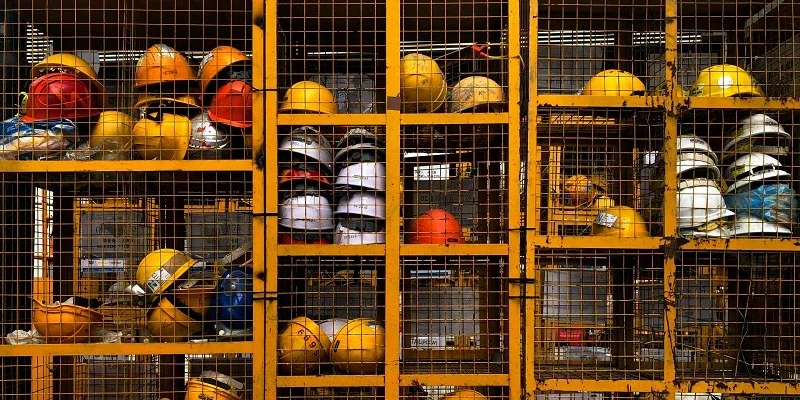Workplace safety is important in the construction industry. Construction, one of the most dangerous industries around the globe, leads to tens of thousands of short- and long-term injuries every year. the major hazard comes from high falls, with work at height accounting for 26% of fatal injuries in the workplace. Extra risks are posed by vehicle and heavy object movement, falling objects from height, underground high-voltage power lines, confined spaces, high noise scenes and dust & fume-exposed places.
This article takes you through how the use of IoT technology can dramatically improve Workplace safety in these high-risk locations!
What is IoT in workplace safety?

The application of IoT technology in working scenes remains one of the most advanced approaches for safety improvements. IoT is conducive for enterprises to optimize working conditions, gather data information, streamline operations and enhance productivity.
IoT devices cannot offer full protection to workers in dangerous fields. On the contrary, they are useful for managers to cope with a large number of risks that can be avoided. Institutions are enabled to supervise and detect working conditions and the health of staff through IoT technology which is helpful to reduce the contact of risk areas for employees, so as to avoid accidents.
2. How does IoT enhance the workplace safety

(1) Monitor potential risks
One of the features of IoT software lies in predictive maintenance, which can be applied to monitor devices in workplaces. It gives more leeway for people to observe structural failures of any device connections before accidents occur. With the help of predictive maintenance, machine learning algorithms are helpful to predict potential issues before it exerts influence on staff. The strength rests with helping institutions take active action on the basis of data models.
IoT and data analysis technology bring about more centralized and integral monitoring, testing and analysis of data rather than decentralized and manual data and report analysis. With more effective systems, organizations are able to acquire complete information that is helpful to monitor, detect and prevent and potential dangers facing companies.
(2) Improve Safety
The introduction of training plans for employees will be conducive to identifying any potential safety risks. In this way, working environments can be supervised, maintained and recorded through IoT technology to ensure safety. By analyzing and utilizing data, IoT tech can provide staff with occupational health and safety strategies that guarantee workplace safety over a long period of time.
For instance, working schedules of factory staff can be developed with the help of the integration of IoT tools, human resources, and solutions for labor forces, which can minimize the safety threat or ensure the 24 hours of shift for each staff. Potential risks can be spotted if IoT devices with environmental sensors are well-installed in workplaces. The sensor can also help staff understand more about workplaces. And the occurrence of accidents will be lowered if they are well aware of their own working scenes.
IoT monitoring devices deployed in workplaces can give hands to employees, helping them ensure their safe working scenes. The devices that are connected still function properly even in emergencies, so as to guarantee their safety.
(3)Track health condition of staff
The latest body check of staff and inspection of company assets through health monitoring technology(mainly wearable devices) can help improve workplace safety. Cases include: employees can wear watches given by companies that can be connected to IoT servers. Then the data sent by the servers are useful for them to come up with safe decisions. The wearable technology targeted at staff is conducive to optimizing the health and safety of workplaces, enhancing the visibility of operations, simplifying procedures, as well as boosting safety & efficiency, so as to carry out on-site measures. In this case, IoT tools have offered benefits, including the intensified operational efficiency of enterprises and a stronger sense of safety for staff. All of these can not only encourage more staff but increase productivity.
In special cases such as accidents, IoT devices with geolocation functions can also guarantee the exact location of employees, thus carrying out relevant rescues. There are devices that can collect crucial information about the surroundings of the accident in real time so that rescue teams can quickly evaluate the situation to develop an effective rescue plan.
(4) Prevent fire accidents
It is a common scene that fire accidents occur in the workplace but they can still be prevented if they are detected early. Fire safety sensors can detect the increased temperature, which indicates the possibility of a fire that spreads. IoT software strengthens the detection of increased temperature, which is of great importance to fire prevention. With the aid of IoT software or devices that are equipped with fire safety sensors, organizations can detect increased temperature, which then indicates a possible fire at a work site. Early detection plays a crucial role in timely evacuating workers and carrying out key preventive measures. Looking at the working experience of IoT projects of Shengzhe Technology, both fire detectors and IoT sensing devices targeted at hidden hazards such as energy and dangerous gases, play a crucial role in real-time sensing, second-level warning, remote control, aided rescue, etc. The solutions supported by technology applications offer a long-term guarantee for the safe and stable operation of industrial parks and buildings.
(5) Quicken and improve efficiencies of rescue
Rescue actions can be rapidly taken with the aid of IoT devices in the event of accidents.
For instance, IoT devices with geolocation functions can provide employees with an exact location, which is critical for rescue operations. Some devices enable you to gather vital real-time information so that rescue teams are able to rapidly evaluate the situation and figure out an effective rescue measure.
3. What are the difficulties of IoT in the workplace

(1) Unification and Coordination of Technology Standard
Currently, IoT cannot fit into the traditional Internet standards. The perception layer IoT contains heterogeneous data and different devices have various interfaces as well as technical standards; Owe to different kinds of networks used and industrial application directions, the layer of the Internet and application also include various internet protocols and systemic architecture. The current difficulties facing IoT lie in the construction of a unified IoT systemic structure and technical standards.
(2) Platform Management
Being a complex network system, the IoT will inevitably encounter some overlapping parts because of its wide applications in a variety of fields. If this network system doesn’t have a particular integral platform for information sort-out management, there will be a huge amount of redundant information, repetitive work and construction, which leads to the generation of wasteful resources. The strengths of the IoT can not be embodied through the features like independent applications for each field, high cost and low efficiency, which will definitely influence the popularization of IoT. At present, IoT is in urgent need of a unified management platform that is able to integrate all kinds of resources from different industries, enabling itself to create an integral mode of an industrial chain.
(3) Cost
Currently, nations provide active support for the Internet of Things. In a seemingly all-rounded development environment for each country, few IoT projects have chances to be put into actual use and in wide application. Cases include electronic tags and readers, which achieve the most basic RFID technology, which is not cost-effective since their price is out of the expectations of many enterprises. The Featuring multi-hop, sensing network is a self-organized network, which is easily damaged due to environmental and human factors. Therefore, the maintenance-free of this kind of network will be high if it needs to be smoothly working and delivers reliable real-time information in a safe manner. The growth of the IoT is nothing if the cost is not universally acceptable.
(4) Security
The traditional Internet has experienced mature growth and has been utilized on a large scale but there are still security vulnerabilities. Being an emerging product, IoT owns a relatively complicated architecture without a united standard. Also, it still has some prominent security issues in various aspects. Its crucial technology for implementation lies in the sensing network. In cases such as sensors that are exposed to the natural environment, especially those that are placed in harsh scenes, how to keep the network integrity for a long period of time has brought about new challenges to the sensing technology. This means the sensing network must possess a self-recovery function, which is not only controlled by environmental elements but also severely impacted by human elements.
4. Cases of IoT used to guarantee workplace safety

Companies have integrated IoT technologies to further decrease the risks in workplaces. These technologies combine real-time analysis, machine learning, highly-developed sensors and systems with embedded structures to support lots of critical functions.
Physiological Monitoring
Wearable technologies are applied to conduct real-time monitoring of the physiological state of workers. Mitsurugi, a Japanese company with wearable technology, performs actively in this field. The company developed a kind of intelligent clothes made of woven metallic silver fibers that gather a large amount of data about the wearer, such as heart rate and physical temperature. Other products embrace wristbands with biosensors that accurately measure pressure levels as well as glasses that can detect eye movement to identify fatigue and micro-sleep periods.
Environment Monitoring
Sensors for measuring hazardous chemicals like temperature, radiation, gas leaks and carbon monoxide, can automatically give warnings to staff to pay attention to insecure exterior environments. What’s more, visual imaging software can map workers’ work environments in 3D to facilitate effective two-way communication between supervisors and field personnel and to provide real-time assistance to workers in severely hazardous environments through remote guidance (e.g., guide a miner trapped in a tunnel to find the best way out).
Situational Awareness, Training & Behavioral Data
Augmented reality (AR) technology offers new ways to support decision-making through holograms provided by physical devices. On the contrary, virtual reality (VR) technology provides immersive situational training without relevant risks in the real world. These technologies also provide valuable behavioral data that can be utilized to evaluate a worker’s level of risk tolerance and ability to respond to hazards.
Proximity Detection
Proximity detection systems make use of wearable sensors to monitor the worker’s location to learn about their movement and give warnings of nearby threats. One case is radio frequency identification (RFID), which measures the distance between workers and mobile equipment and then warns them of possible collisions. Another device is the “intelligent helmet,” which has instant detection of accidents to identify the worker’s position and send a warning of coordinates to safety control centers, which then make contact through video & audio and communicate with workers until they acquire assistance.
Exoskeleton
By analyzing a worker’s activity and providing the necessary support, exoskeletons can help lift heavy objects and prevent musculoskeletal disorders. For example, invisible chairs used by factory floor workers are fixed to the back and legs to provide support when workers sit or squat. What’s more, Exoskeletons are applied to detect workers’ movements to identify repeated motions and periods of constant overexertion.
5. IoT solutions for workplace safety

(1) Faster emergency response
When staff encounter a critical incident and report it to the command center in an instant way, scheduled automated workflows can be adopted to expedite evacuation and rescue events. For instance, when a worker falls high or suddenly faints, an alarm will be activated at the safety control center so that medical aid can be initiated in a timely manner. Likewise, if a certain gas level in the air runs over the acceptable threshold or an upcoming explosion is monitored, staff is immediately informed and promptly evacuates from dangerous areas.
(2) Improvements in worker health and productivity
The Increase in visibility into the work environment also helps avoid long-term exposure to harsh conditions such as carbon dioxide, radiation, noise, heat or heavy humidity. Sensor data allows managers to watch for any signs of fatigue, dehydration, or exhaustion that workers experience so they can be motivated to take breaks as needed. Reducing overexertion at the lowest level not only enhances overall productivity but decreases the dangers of injury, accidents and chronic illness.
(3) Diagnose and prevent future accidents
Apart from the reactive response, predictable analytics powered by large amounts of on-site sensor data can be used to forecast and prevent risks ahead of time. For instance, intelligent sensors mounted on rock anchors can detect seismic activities in mines below the ground and monitor possible collapses in mines that are full of instability. If a risk is spotted, operations in these places are banned or preventive action plans are taken to prevent accidents.
Similarly, condition monitoring and predictable maintenance reduce failures of critical assets like pumps and pipelines to the lowest level so as to lower the explosion risks of gas leaks. Remote tracking makes it possible to identify functioning heavy machinery that is not in use and shut them down, which is useful to avoid equipment accidents and boost efficiency.
Precondition: all-rounded on-site internet connection
Among all the enormous potentials, a major difficulty in carrying out IoT for staff safety solutions lies in spotting feasible on-site connectivity. Many high-risk industrial areas, such as construction sites, plants, offshore rigs and underground mines, are featured by difficult terrain, significant physical obstructions and vast areas. These adverse conditions can lead to shadows, attenuation, diffraction and reflections that can impede effective radio propagation.
Low Power Wide Area Networks (LPWAN) offer a wide range and deep building penetration, providing a versatile communications solution for industrial parks that feature dispersed geographical locations and dense architectures. The ultra-low power consumption also prolongs battery life, developing low-power WANs into a practical solution for the connection of IoT devices powered by batteries such as wearables and environmental sensors.
















